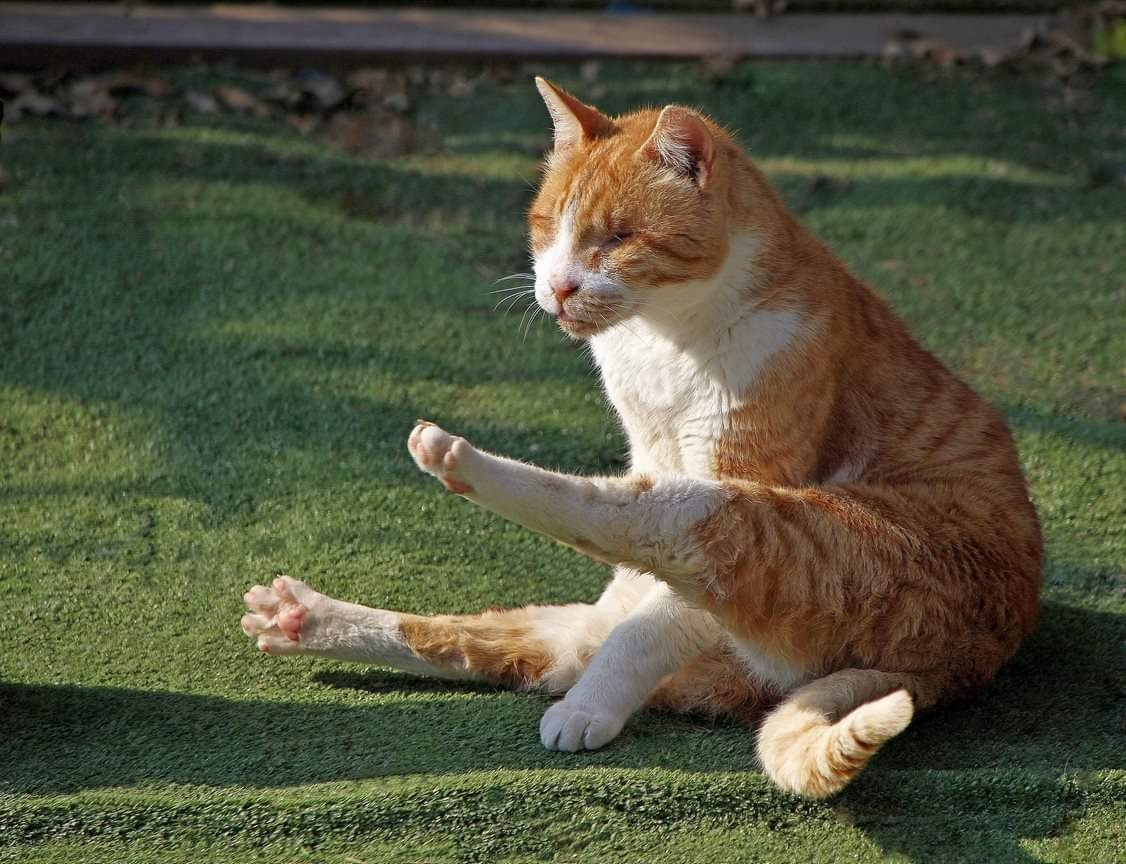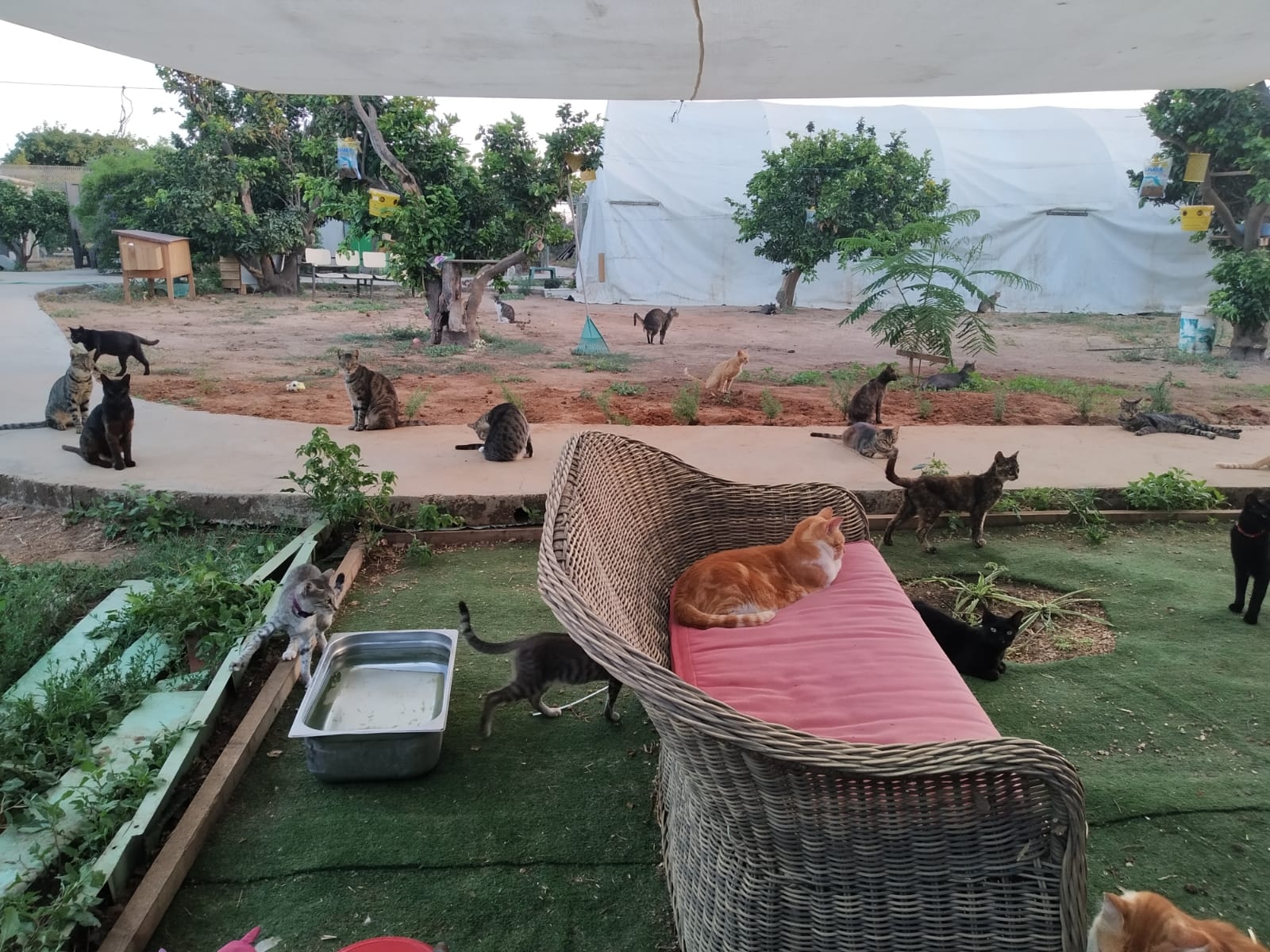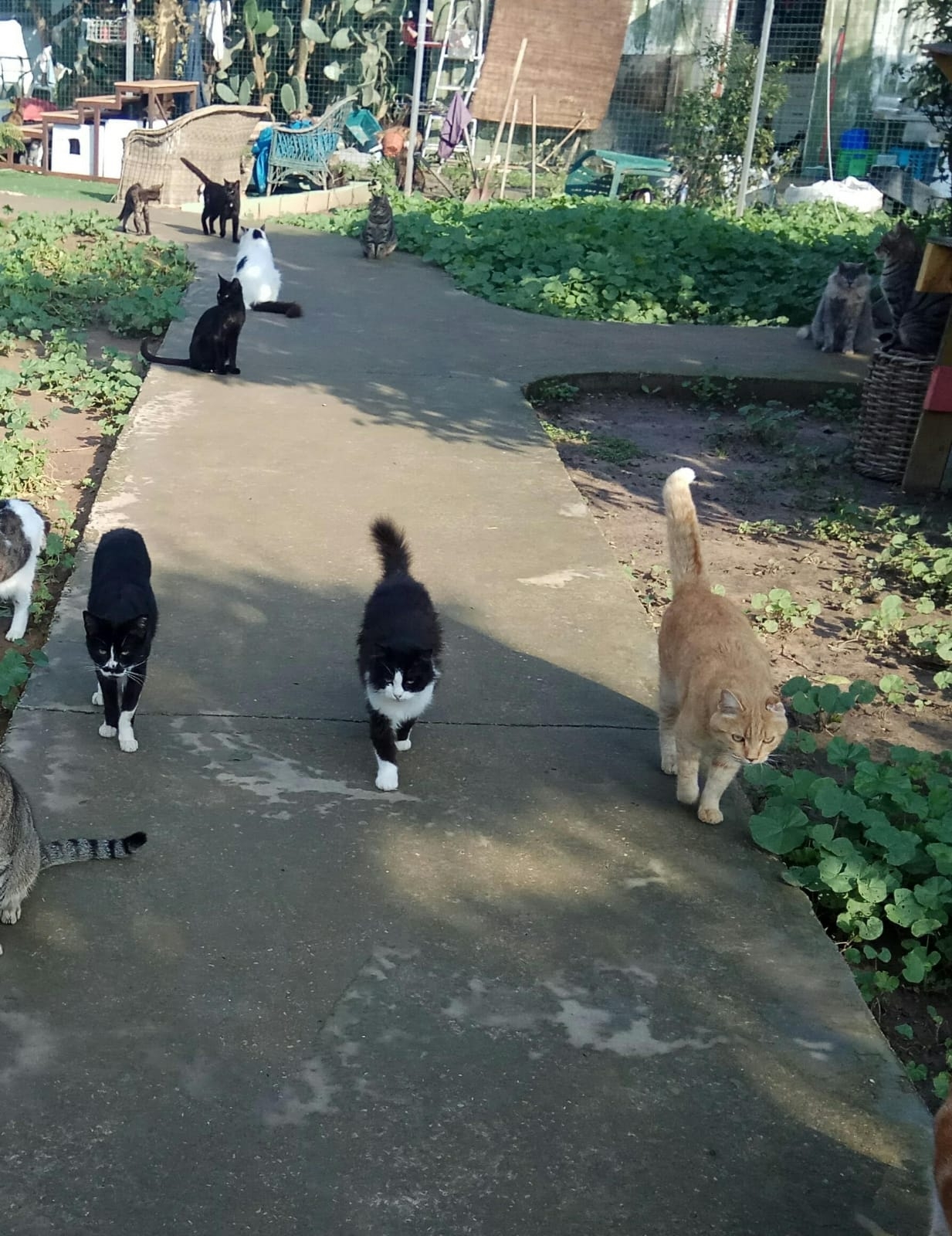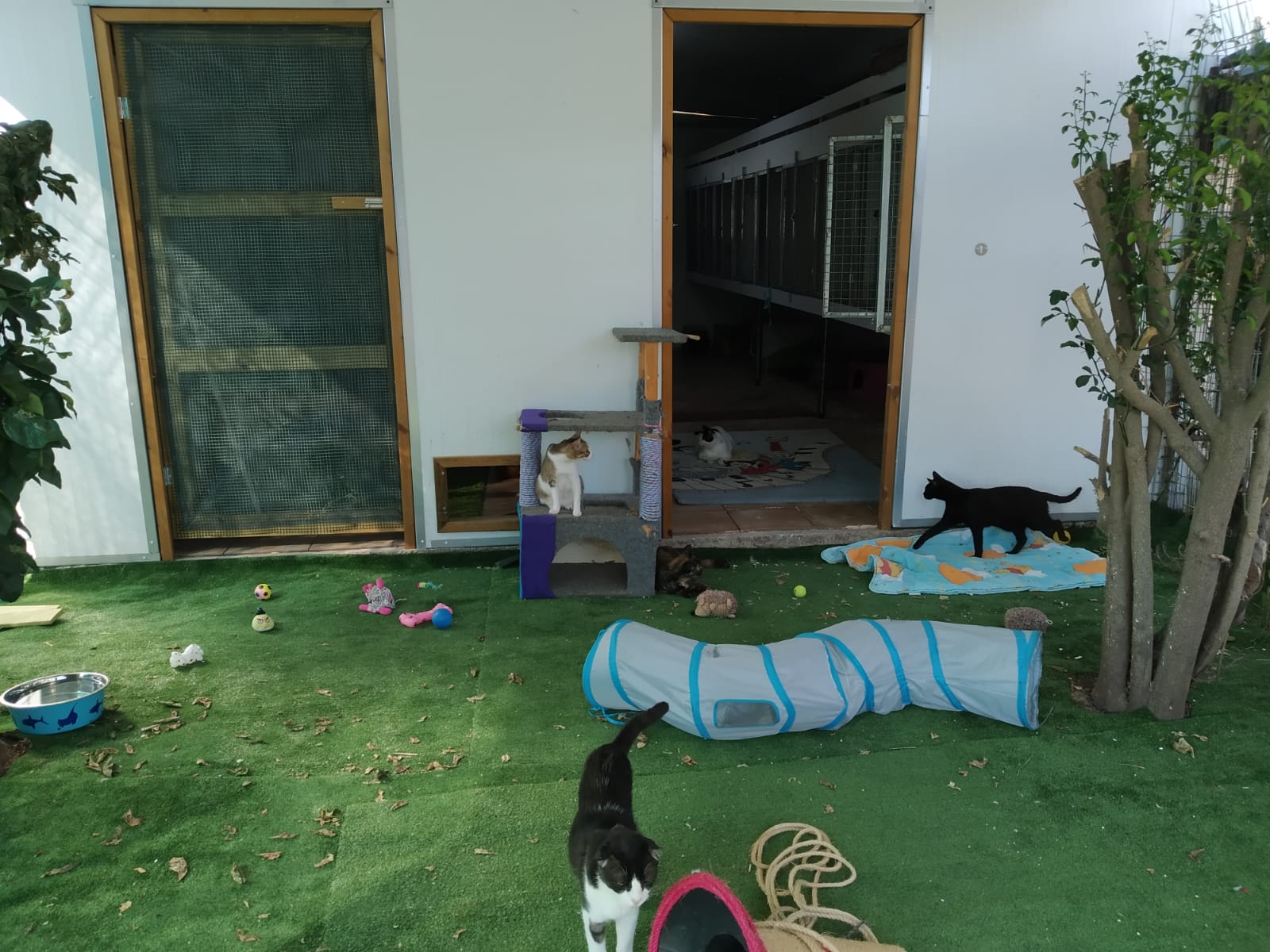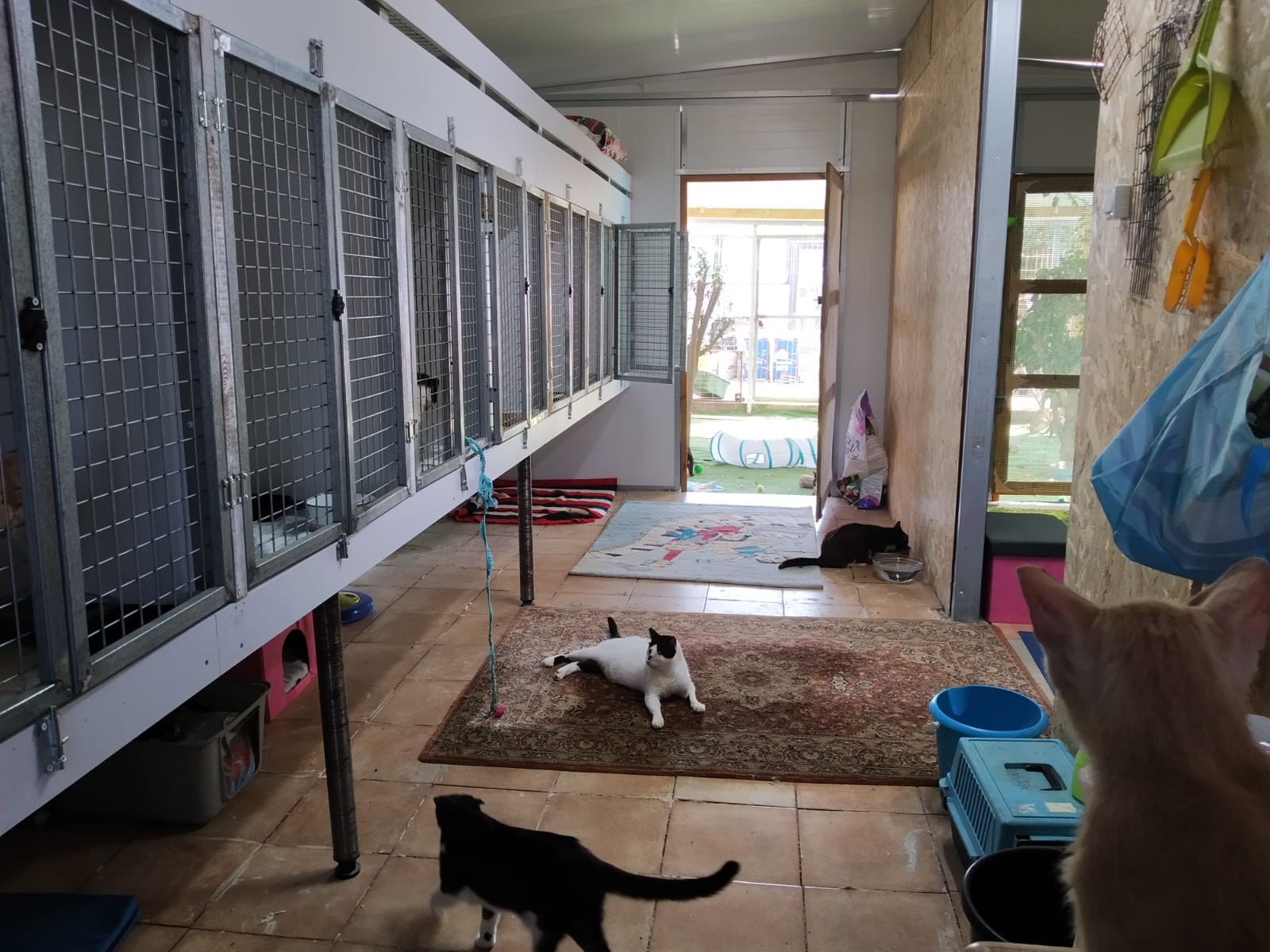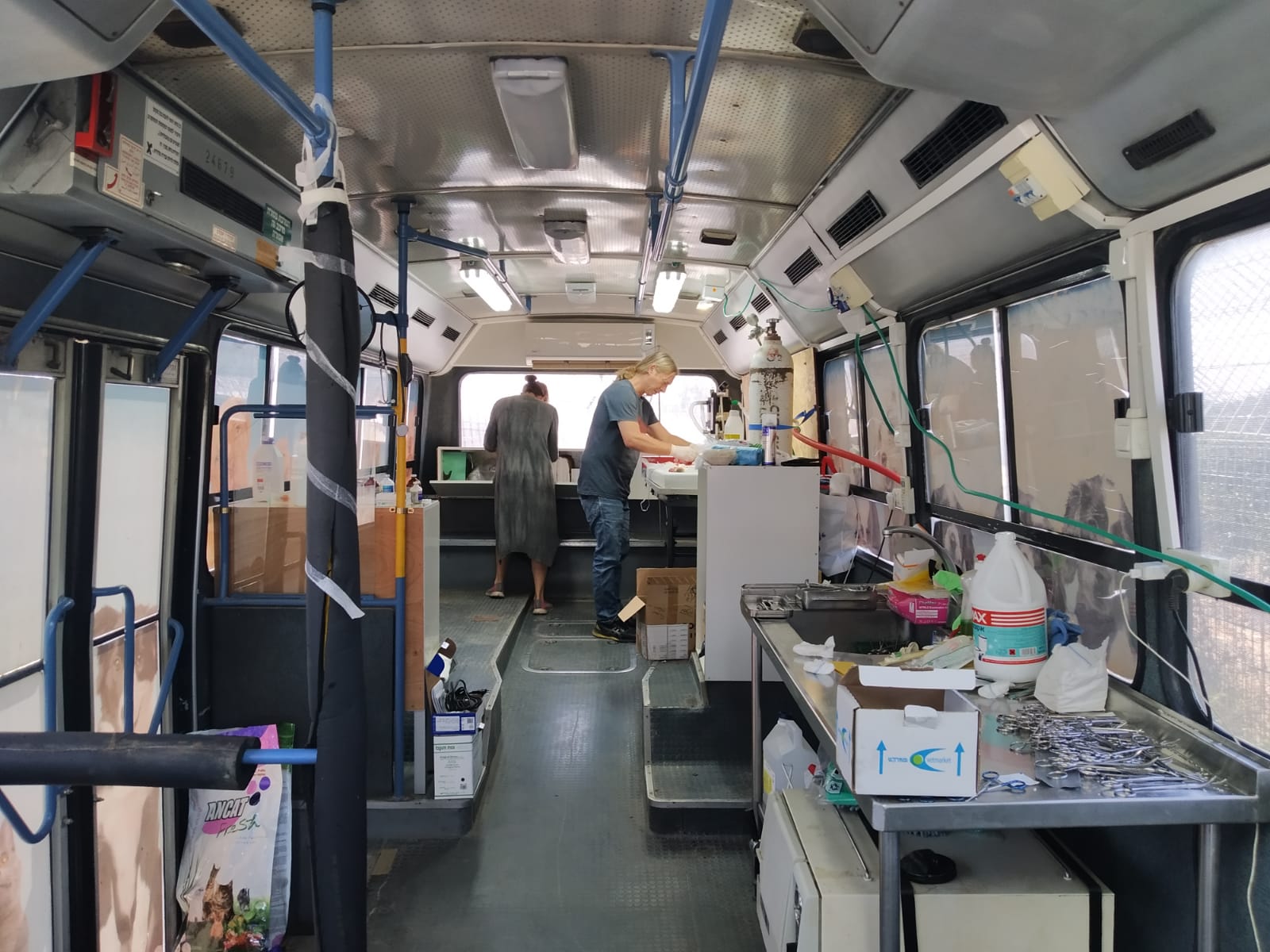About us in the papers
The kibbutz of cats: A visit to Israel’s biggest feline shelter
A visit to the House for Rescuing Cats, a haven of kindness established by Irit Engel, reveals the struggles and the triumphs of animal activists in a country that still largely lacks compassion for its four-legged friends
Orna Rinat | Haaretz | 10 October 2019
Louie stands at one end of the ladder set up parallel to the ground. He turns up his face, seeks the voice calling out, raises a paw to feel his way, stretches it until he finds the next rung, and then follows up with his hind legs.
Louie is a blind orange cat. He can’t see the next rung of the ladder, but he knows that it’s there and trusts the voice. He wants to reach it. The voice is that of Irit Engel.
A few weeks ago, I sat in the yard of the House for Rescuing Cats in the northern city of Hadera and tried to drink coffee. It’s not easy to drink coffee, let alone smoke and drink coffee, with a gang of cats — including a chicken — surrounding you. They are convinced that you exist solely to serve them. If you stop petting them for a moment, they will scrape at your hands to remind you gently that you’ve deviated from your assigned purpose.
Irit tried to rest a bit, after 10 straight hours of work, when suddenly a van stopped at the gate and Alon, Hadera’s municipal inspector, got out. He apologetically laid a carrier on the table which contained three kittens whose mother had been run over. The municipality was called and Alon knew that if no solution was found, they would be sentenced to death. He brought them to the only person he knows who “cares about cats more than they care about themselves,” as he put it.
Like tens of thousands of people in Israel, Irit began taking care of cats because she was troubled by seeing them suffer. Some two million cats live on Israel’s streets. The lucky ones know that at a certain moment of the day a parking lot attendant, a Tel Aviv hipster, an ultra-Orthodox woman or an elderly woman will show up to give them food, pet them and coo in affection.
Opponents of feeding street cats claim sometimes that these people are drawing selfish satisfaction from taking care of animals. Not only does this view ignore the fact that taking care of stray animals is perhaps the most demanding mission animal welfare activists can take upon themselves, but this is also a psychological reduction based on the assumption that the pain felt by a person who sees an animal suffering cannot, on its own, justify such devotion. The animal isn’t important enough to merit this. This isn’t surprising, especially in a society where it is considered completely justified to celebrate special occasions by eating foods produced through the torture and death of billions of animals. Many in Israel still think that to take pity on living creatures is narcissistic.
Those who feed the animals often sink into debt and have to put up with hostile reactions. They wander the world like little Ussepe, the child from Italian writer Elsa Morante’s novel “History,” who even in a refugee camp during World War II saw what environmentalists who call for people to stop feeding cats failed to observe.
Like all these people, Irit was also close to collapse. One summer, there were 17 nursing kittens in her bed, and everyone who has taken care of even a single kitten knows how difficult that can be. But Irit decided to turn her despair into a vision and set off on a path to make it come true. Gradually, with great effort and with the help of donations, she founded what is today the largest, most progressive and happiest cat shelter in Israel.
It started in an abandoned building in a little field in Hadera. There were around 90 cats there, among them dozens of kittens, plenty of which were chronically ill. Irit took care of them around the clock.
Places like these are usually cold and depressing, but not Irit’s shelter. The shelter was filled with rugs, hammocks, toys, climbing equipment and cushions. There was a separate yard set up for kittens with nets and the sick were put in different wings. The psychological component was very important to Irit from the start.
About three years ago, I saw a kicked kitten running across the street and trying to hide in a wall. When I ran after it, it fell from a height of three stories. It lay there on its side, small and quiet, like a baby fast asleep. When I picked it up, it cried out suddenly in a low and deep voice, which was difficult to believe had come out from this tiny body of a two-month-old kitten. It reminded me of the only cry that Kai, a ginger kitten of three weeks, made a moment before he died in my arms. I had already heard a cry like this once from behind a wall, from an apartment in which an elderly neighbor was dying.
Irit put the kitten that fell in a huge aluminum cage filled with hammocks and toys. For months, it hid in a small igloo in the cage and would only come out to play when it thought no one was looking. After a few weeks I received a joyous message from her: “Hi, I found it an antisocial friend just like it.” She named the ailing cat I found Sacco and called its new friend Vanzetti, after the two Italian anarchists.
Witnessing wonders
In 2015, the ruined building was designated as a “convalescent shelter for cats” and called the Hatuliyya, meaning roughly the Cat Place. Irit added seven volunteers.
“We accepted countless cats that were on the verge of death, blind, limbless, abandoned kittens, etc.,” Irit wrote on Facebook. “We devoted days and nights to veterinary treatments, hospitalizations, assisted feedings and especially lots of love. We were witnesses to wonders in which, against all odds, cats got better.”
In July 2018, Irit became the manager of an established foundation in Hadera, “The House for Saving Cats,” which had fallen apart. It was home to nearly 300 cats in a state of total neglect, and only one volunteer would come every day to feed them. It was a very large space situated among fruit orchards in the Hadera neighborhood of Beit Eliezer and surrounded by a fence. For a year she labored there with the help of volunteers to set it up and transfer 90 cats from the Hatuliyya. She set up separate fenced areas for sick or disabled cats that couldn’t manage in the large open space, with sealed-off and open parts as well as heated cabins. All of the areas were filled with cushions, easy chairs, and climbing and playing facilities. Of the 400 cats that lived there, 80 were blind.
For animal lovers, this is a very moving place. No more institutional cages into which dozens of cats are crammed. Instead, Irit’s spot is a huge space, surrounded with fruit orchards and filled with greenery, like a kibbutz. A cat kibbutz. They wander around with a sense of self-worth, their tails held high. Among them we saw little Sacco. The cat that came out of its cage at the Hatuliyya only when it was certain that no human being was spotted was now sitting calmly and quietly, surrounded by a gang of cats, warming itself in the sun for the first time in its life.
Behind all of this, what goes on is an unceasing war against the constant threat of suffering and death, which many shrug off when it comes to animals.
For Irit, the suffering of animals is not a philosophical issue. It is a concrete concern over creatures that don’t want to feel pain. If you betray the animals’ trust, you will carry that feeling forever. How can one dismiss the importance of the animals’ yearnings, their ability to convey them and people’s ability to feel them? For this exact reason, Irit and her volunteers fight over each and every cat’s life.
Like Sanibel, a blind cat that for years, when the place was neglected and abandoned, would walk around itself in circles until Irit came and began petting it. Finally, the cat stopped its anxious pacing. Another example is that of Malinka, a cat that was brought in while suffering from deep sores filled with maggots that Irit labored for hours to remove with her hands. Eventually, Malinka got laser treatments, which it required because it needed regular extraction of urine due to nerve damage. There are hundreds like these every year.
Animals’ deep feelings
The reward for all this is the cats themselves. They don’t say thank you, not in words. But signs of happiness, excitement or distress are absolutely illustrate what they feel. There is no division between their expressions and their feelings. When Nano was hospitalized, the vets said that he didn’t touch his food all day long. Only in the evenings, when it saw me in the entrance to the ward, coming to visit, would it begin to eat.
Whoever has heard shouts from the slaughterhouses, whoever has cared for animals, knows the emotions are a big component of animals’ lives. Authors and poets have said this since the dawn of time, and were accused by leading scientists of erring by “humanizing” the animals.
Today, scientific research also recognizes that it dismissed for many years the mental capacities of animals. And still, humanity hasn’t drawn the required ethical conclusions from this fact.
On the hand, it has filled the world with closed-off facilities where billions of livestock die every year to serve people’s whims, and on the other hand it annihilates nature itself and wild animals living in it.
Nature authorities are continuing to try to fight this genocide by hurting the weakest links in the chain — the animals themselves.
Ecologists say that spaying and neutering cats doesn’t help; they learned this from “studies.” But these studies are worthless, as long as spaying and neutering are not tested at a meaningful level. In the meantime, the budget for this in Israel is miniscule. Ecologists also know that many of the problems solved today with killing can be solved with money. And there is money, in the hands of the same tycoons who are also responsible for the ecological holocaust.
They have never actually attempted to lead with regard to animals – all of them, livestock, wild animals and street animals – a policy that extends kindness, that isn’t subjected to cost-benefit considerations. Perhaps the results would surprise ecologists as well. One of the worthy models of this type with regard to street animals is the place established by Irit. Instead of killing and starving them, we need the budget for more places like this, in which they are all spayed and neutered. We also ought to continue to allocate funds for spaying and neutering on a wider scale.
Irit has already achieved much. She has established a place like no other in Israel, and a few months ago raised in a massive effort 65,000 shekels ($18,670) , which was matched by a donor, and with which she founded and outfitted a clinic and rehabilitation facility at her place. She can work 14 hours a day, deal with government offices, marketing, fundraising, and endure with courage the great suffering she sees every day. But there is one thing she can’t handle: The fact that it’s never possible to know if the donations will come in next month, and the concern over what happens if they don’t. The existential uncertainty is intolerable.
She received 60,000 shekels from the Environmental Protection Ministry this year, while her monthly expenses were between 30,000 and 40,000 shekels, for things like food, medication, electricity (which includes 24-hour heating in the cabins for sick cats) and veterinary treatments. The facility has already seen its electricity cut off due to a lack of funds. Hospitalization of several days in a clinic, including observation and the administration of medication, can cost thousands of shekels. And every day she receives tens of requests for help.
The only way this wonderful endeavor can continue to exist is with donations. Regularized automatic transfers are the most desirable, even small sums, in order to grant those devoting their lives to cats a certain feeling of security. Everyone who worries about street cats knows how important it is for this shelter to succeed and endure.
If you wish to support the House for Rescuing Cats, please visit this link.
Read this article on Haaretz

